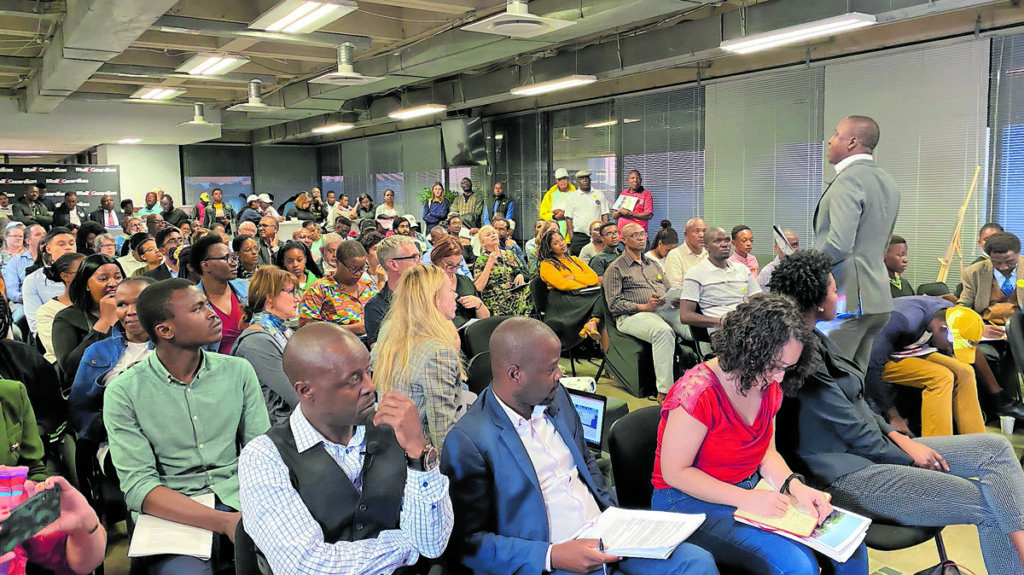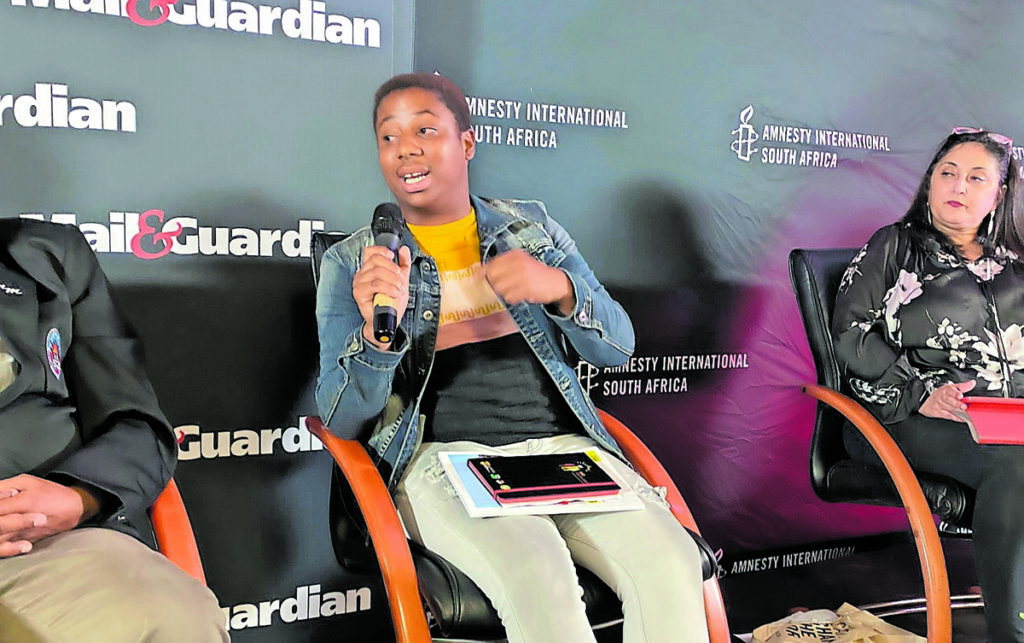The panel was moderated by Robert Shivambu (far left) and included, from left, Elijah Mhlanga from the DBE, Matakanye Matakanya of the NASGB, education activist Ayanda Makebenge, Shenilla Mohamed of Amnesty International South Africa, and Samantha Brener of Section27. (Amnesty International)
SPONSORED
Nelson Mandela famously said: “Education is the most powerful weapon which you can use to change the world.” It seemed fitting that the quote was mentioned at the launch of the Amnesty International report, Broken and Unequal: The State of Education in South Africa, on February 11. The date marked 30 years since the release of the former president from prison, but there was little cause for celebration at the publication of the report which took place at the latest Amnesty International South Africa and Mail & Guardian Critical Thinking Forum, held at the Mail & Guardian offices in Braamfontein.
“South Africa is failing too many of its young people when it comes to education. Although it has made significant progress since the end of apartheid in widening access this has not always translated into a quality education for all pupils. The system continues to be dogged by stark inequalities and chronic underperformance that have deep roots in the legacy of apartheid, but which are also not being effectively tackled by the current government,” was the main takeaway from the report.
The launch included a panel discussion which delved into some of the issues raised by the report. The panel was moderated by Robert Shivambu, the media manager for the Southern Africa Regional Office of Amnesty International. Ayanda Makebenge, education activist, Shenilla Mohamed, executive director Amnesty International South Africa, Samantha Brener, attorney at Section 27, Matakanye Matakanya, general secretary of the National Association of School Governing Bodies (NASGB), and Elijah Mhlanga, spokesperson for the Department of Basic Education (DBE) made up the panel.
 It was a full house at this Critical Thinking Forum with extra seating brought in, and the audience was engaged throughout. (Amnesty International)
It was a full house at this Critical Thinking Forum with extra seating brought in, and the audience was engaged throughout. (Amnesty International)
Focusing on Gauteng and the Eastern Cape, the Amnesty International report found that the South African government continues to miss its own upgrading targets. They found that many schools in those provinces have poor infrastructure and lack basic facilities. These included badly maintained buildings that have never been renovated. Many of these buildings date back decades to the apartheid era and were built with unsafe materials. The findings of the report were put together in conjunction with a survey that Amnesty International conducted with the NASGB.
Welcoming the audience to the launch, Samson Ogunyemi, the economic, social and cultural rights researcher and campaigner for Amnesty International South Africa said the report could not be launched without remembering what Nelson Mandela said about education. Ogunyemi also took the audience through the methodology of the report which decided to assess the quality of education in poorer communities by focusing its visits on the no fee schools (quintiles 1-3) that serve these communities in both urban and rural areas.
The report found that 19% of schools in South Africa have illegal pit latrines, 37 schools have no sanitation, 86% of the schools have no laboratories while 239 schools lack electricity.
The research for the report was carried out between November 2017 and June 2019. Desk research drew on reports from international and national non-governmental organisations, the UN, regional human rights bodies, academics and the media as well as government data including public spending on education and education outcomes disaggregated by region. Field research for the report was conducted in Gauteng, the Eastern Cape and the Western Cape. During the field research, Amnesty International visited 12 public schools in Gauteng and 26 public schools in the Eastern Cape.
A video was shown just before the panel discussion delved into the intricacies of the report. An education activist and students spoke about the challenges facing the school system. Panelist Ayanda Makebenge featured in the video as well and spoke about how, as a 13-year-old, she went to the department to demand more textbooks for the learners. The video emphasised the report’s point that the state of South African education was in disrepair.
 Eastern Cape education activist Ayanda Makebenge speaks about the lived experiences of learners. (Amnesty International)
Eastern Cape education activist Ayanda Makebenge speaks about the lived experiences of learners. (Amnesty International)
The launch was well-attended with extra seating brought in. The audience consisted of members of Amnesty International, learners, teachers, parents and people interested in the education sector. It was an engaged audience that listened and participated with the panel.
Amnesty International’s Mohamed raised the issue that, in this day and age, a child’s education still depends on the colour of their skin and where they were born. She said the Department of Basic Education has failed by their own admission to meet targets within the education system. “We are robbing many children, particularly from poor communities of a future,” said Mohammed adding that in spite of austerity conditions, funds need to be utilised to make a difference in the system.
“The situation is very bad,” said education activist Makebenge. Following on from the comments she made in the video, Makebenge said the economic situation in the country is no excuse for the government to not fund basic education. She said many students, including herself, were forced to walk for long distances to school. This made it very difficult for learners to concentrate in schools. Another issue was the lack of resources. Makebenge said at certain points during her schooling, seven learners would be forced to use one textbook. That made it difficult for students to study at home for exams and to do their homework.
Representing the school governing bodies, NASGB’s Matakanya said the biggest problem facing the education system in South Africa is quality. He said students should not have to travel long distances to be able to access quality education.
Human rights organisation Section 27 has worked on the issue of quality in education for a considerable amount of time. The organisation in particular has worked on the case of Michael Komape, the five-year-old learner who drowned in a pit toilet. Berner from Section 27 first explained to the audience what happened to Michael Komape. She said it’s important for people to imagine those conditions and understand Michael’s death as a symptom of the broken system.
Responding last to all the comments that had been made, the department’s Mhlanga said that the department had reportedly not seen the report before the event. He instead chose to respond to the issues of the education system more generally. Mhlanga said while the department is not happy with the progress being made, the issue was complex and that it’s important to understand which arm of government has the power to respond to the issues directly.
The floor was then opened for questions. Many of the audience members raised the point that many of the issues were known, and that there is now a need to create solutions through government, activists and civil society working together.
During her closing statement, Mohamed left the room with a final thought that it was important to remember the children during all the discussions. She said the event might have been a back-and-forth between the civil society organisations and government with defensiveness from both sides. Mohamed said the panelists and audience members have painted the picture of the child, and that if organisations and the government start thinking of the child, then people will start thinking of solutions.
In closing, Ogunyemi encouraged audience members to go through the comprehensive 120 page report. He said that the audience should engage with Amnesty International after reading the report and come up with solutions for dealing with the issue of the “broken and unequal” South African education system.